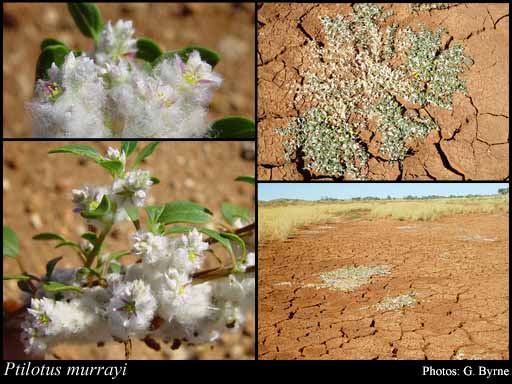- Reference
- Fragm. (Mueller) 3:145 (1863)
- Conservation Code
- Not threatened
- Naturalised Status
- Native to Western Australia
- Name Status
- Current
Prostrate to decumbent annual, herb, 0.01-0.15 m high, Spikes usually 3cm or more long. Fl. pink & green/white & pink, Feb or May to Aug. Clay. River banks, mud flats.

Scientific Description
Annuals, stems several, more or less prostrate, glabrous. Leaves present, 1-3 mm long, glabrous; basal rosette absent; cauline leaves opposite. Spikes white, ovoid or cylindrical, solitary or clustered, with densely arranged flowers. Bracts 1.3-1.6 mm long, colourless, glabrous, not awned or mucronate, with an obscure midrib. Bracteoles 1.3-1.5 mm long, colourless, glabrous, not awned or mucronate, with a prominent midrib. Outer tepals 2.7-3.3 mm long, entire. Inner tepals 2.5-3 mm long, glabrous within. Style 0.4 mm long, straight, centrally fixed to ovary. Seeds glossy, black. Distribution: Northern and Eremaean Botanical Region; IBRA regions: Dampierland.
Distribution
- IBRA Regions
- Carnarvon, Dampierland, Gascoyne, Pilbara.
- IBRA Subregions
- Augustus, Cape Range, Chichester, Fitzroy Trough, Hamersley, Pindanland, Roebourne, Wooramel.
- Local Government Areas (LGAs)
- Ashburton, Broome, Carnarvon, Derby-West Kimberley, East Pilbara, Karratha, Port Hedland, Upper Gascoyne.